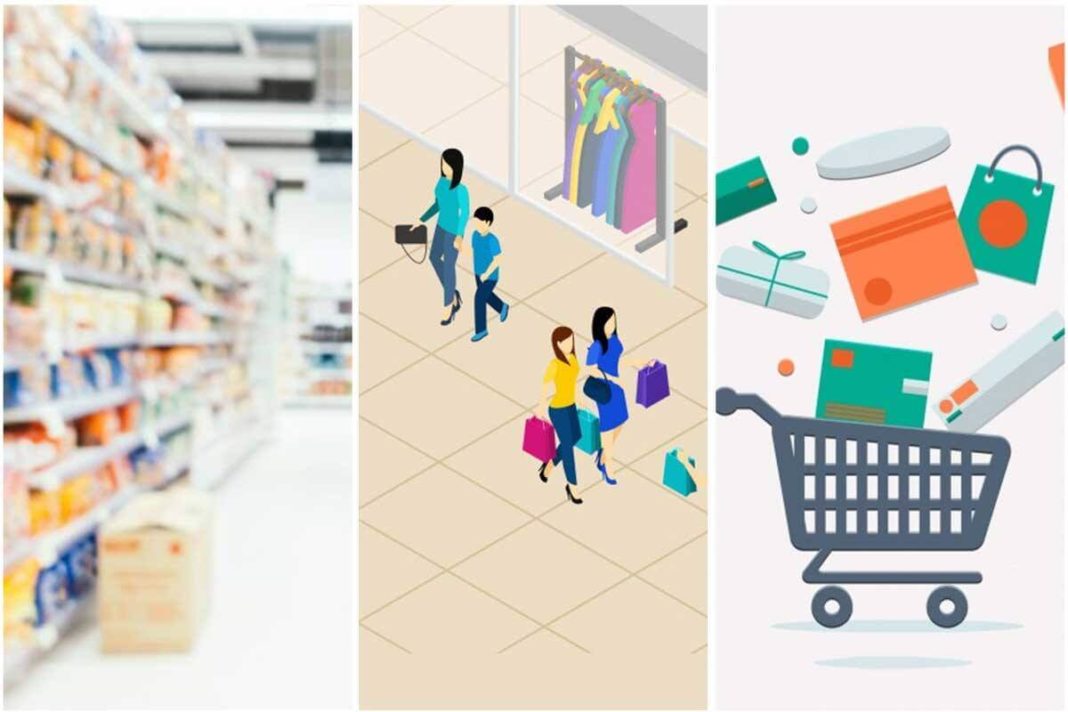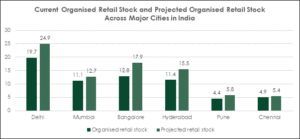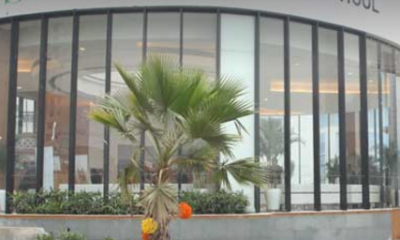Report
Organized retail stock reaches 64.3 million sq. ft as of H1 2021


CBRE South Asia on October 7 announced the findings of its report titled ‘India Retail Reboot 2021’, which highlights that India’s organized retail stock has reached 64.3 Mn Sq. ft as of H1 2021 and is expected to cross 82 Mn Sq. ft by 2023.
According to the report, Delhi & Bengaluru are leadings the sectors’ growth with an expected addition of over 5 Mn Sq. ft of the overall organized retail stock respectively followed by Hyderabad expected to add over 3 Mn Sq. ft.


The report further highlights that with the onset of the pandemic, the consumer behavior shifted towards ‘conscious buying’, leading to a significant shift in consumer purchase behavior both across physical retail and E-commerce. The F&B, E-commerce, pharmaceuticals, and the traditional grocery retailers as the top performing sectors witnessed steady growth despite the pandemic.
Commenting on the announcement, Anshuman Magazine, Chairman, India & South-East Asia, Middle East & Africa, CBRE, said, “The overall outlook for the Indian retail real estate market continues to be positive at the back of an accelerated vaccination drive, policy reforms, and increasing urbanization. Moreover, with more investors looking at REITs and fractional ownership for the commercial segment, the sector is embarked on a growth trajectory.”


With the renewed demand and bounce back of retail, we are seeing a number of international brands both in the retail & the F&B sectors showing interest in the country and we expect to see them enter India starting early 2022 which would contribute to the overall sectors’ growth going forward”
Future trends for sectorial growth:
Apparel and Footwear:
- Pent up demand is likely to lead to a strong rebound
- Retailers are expected to continue ramping up their digital / online capabilities
- Store-based retailers will focus on unique shopping experiences
- Malls focussed brands are likely to expand in standalone / mixed use developments to widen their footprint.
- A few brands are altering their store sizes and layouts as well
Health & Beauty:
- As purchasing patterns normalize, beauty specialist retailers are anticipated to make a strong comeback
- A number of new multi-brand formats are evolving and growing, both online & offline
Electronics and Appliances:
- All national retailers have significantly improved their online presence and have tried to address all the customer demands.
- Multi-brand outlets are likely to become a preferred choice among consumers and retailers such as Croma and Reliance Digital are expected to continue expanding
Department Stores:
- One-stop shopping experience format is likely to remain popular among consumers
- All department stores are finding innovative ways to engage with their customers, and some have also used personalized / online platforms to improve sales.
Hypermarkets, Supermarkets and Traditional Grocery Retailers:
- Consumers will continue to remain value-conscious
- Comeback of non-essential sales is likely to aid recovery and growth across supermarkets
- Low penetration of modern grocery retailers, lower real estate costs and availability of larger spaces offers tremendous expansion opportunities in tier II and tier III cities
E-commerce and F&B E-commerce:
- E-commerce is expected to witness high growth going forward as well and but would co-exist well with store-based retail channels. Integration of the two is likely to increase.
- Dark kitchens / stores in partnerships with online & other store-based retailers will be the key to offset logistical challenges in the future
- Expansion into tier II and tier III cities is likely to be the next stage of development in the F&B e-commerce category as well
Retail Outlook:
The pandemic created an urgent need for the retail sector to adapt to the evolving market landscape. Trends that were on a multiyear trajectory saw dramatic acceleration and the retail industry witnessed more innovation in the past year than it did in the prior decade.
CBRE has identified six imperatives that are expected to help retail stakeholders adapt to a changing consumer landscape while pursuing new opportunities.
- Restructuring retailer-landlord relationships – Post the pandemic, more partnership like agreements started to surface between landlords and retailers. Landlords provided several relief measures to accommodate retailers, ranging from temporary rental rebates, rental reductions, and deferments with some also exploring lease restructuring and fit-out subsides.
- Navigating the digital shifts –Technology in retail is rapidly evolving; especially post the pandemic. Virtual fitting-room technology will help to synchronise the store’s inventory and point-of-sale systems, enabling stores to catch up to data-rich e-commerce by providing insights on data points such as time spent in fitting rooms and conversion rates.
- Tapping the altering consumer behaviour – Consumers today are extremely agile, volatile, demanding and tech-savvy. Given their preferences and the pandemic related disruption, retailers should focus on reinventing their marketing strategies and think of innovative ways to know their consumers better.
- Omnichannel to be the new omnipotent: Online shopping has enabled customers with this convenience in a safe environment. The change in consumer shopping patterns has ensured that retailers consider omni-presence. Omni-channel is expected to be the fallback plan for businesses during uncertainties / lean economic cycles.
- Reshaping the idea of a “store”, free standing stores to proliferate – With inventory management already being optimised with the aid of predictive demand analytics, brick and mortar stores may eventually become inventory free as purchases would be dispatched from warehouses to consumers’ homes upon payment. CBRE foresees the redistribution of space between the various areas of retail stores such as fitting rooms, product testing zones, pick up counters and stockrooms.
- Rethinking retail asset management strategies, health, and safety to remain paramount – Physical spaces are likely to be re-thought and social distancing may remain in effect going forward as well – attention will be paid to vaccinated staff Developments that are currently under construction / planned are expected to make provisions for more open and green spaces in their design layouts. In addition, adoption of PropTech is likely to take centre stage in the maintenance across the retail-built environments.
-



 News3 weeks ago
News3 weeks agoKW Delhi 6 Mall Onboards New Brands
-



 News3 weeks ago
News3 weeks agoManasum Senior Living Launches IKIGAI GOA, A Senior Living Community in North Goa, in collaboration with Prescon Homes
-



 News2 weeks ago
News2 weeks agoGodrej Properties Sells Rs 3k cr+ Homes of Godrej Zenith, Gurugram, within 3 days
-



 News3 weeks ago
News3 weeks agoBridging India Divide: Top 5 Tier- 2 Cities to Focus On
-



 News3 weeks ago
News3 weeks agoCommercial Realty Gets Tech Savvy: Fast Construction, Enhanced Convenience
-



 News3 weeks ago
News3 weeks agoMultipoint Connection – A Definite Boon
-



 News2 weeks ago
News2 weeks agoRBI’s Status Quo on Key Policy Rates to Help Maintain the Real Estate Growth Momentum, Say Industry Stalwarts
-



 News3 weeks ago
News3 weeks agoSacred Cities See a Retail Boom as Spiritual Tourism Surge: CBRE Report


















